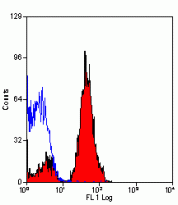ARG23534
anti-CD321 / JAM1 antibody [H202-106] (Biotin)
anti-CD321 / JAM1 antibody [H202-106] (Biotin) for Flow cytometry and Mouse
Overview
| Product Description | Biotin-conjugated Rat Monoclonal antibody [H202-106] recognizes CD321 / JAM1. Rat anti Mouse CD321 antibody, clone H202-106 recognizes murine CD321, which is also known as junctional adhesion molecule 1 (JAM-1). CD321 is a 32-41kD glycoprotein, which shares similarities with related proteins JAM-2 and JAM-3. CD321 is a multifunctional protein that is primarily expressed by platelets, endothelial and epithelial cells. The CD321 protein co-localises with tight junction molecules in both epithelial and endothelial cells and plays an important role in the regulation of junctional integrity and permeability. In addition, CD321 is a ligand for the integrin LFA-1 and is also involved in the transmigration of leucocytes. |
|---|---|
| Tested Reactivity | Ms |
| Tested Application | FACS |
| Host | Rat |
| Clonality | Monoclonal |
| Clone | H202-106 |
| Isotype | IgG1 |
| Target Name | CD321 / JAM1 |
| Antigen Species | Mouse |
| Immunogen | MTE1/MTE2 stromal cell lines. |
| Conjugation | Biotin |
| Alternate Names | JAM-1; JAM1; Junctional adhesion molecule A; CD antigen CD321; JCAM; JAM-A; Junctional adhesion molecule 1; PAM-1; JAM; JAMA; KAT; Platelet F11 receptor; Platelet adhesion molecule 1; CD321 |
Application Instructions
| Application Suggestion |
|
||||
|---|---|---|---|---|---|
| Application Note | FACS: Use 10 µl of the suggested working dilution to label 10^6 cells in 100 µl. * The dilutions indicate recommended starting dilutions and the optimal dilutions or concentrations should be determined by the scientist. |
Properties
| Form | Liquid |
|---|---|
| Purification | Purification with Protein G. |
| Buffer | PBS, 0.09% Sodium azide and 1% BSA. |
| Preservative | 0.09% Sodium azide |
| Stabilizer | 1% BSA |
| Concentration | 0.1 mg/ml |
| Storage Instruction | Aliquot and store in the dark at 2-8°C. Keep protected from prolonged exposure to light. Avoid repeated freeze/thaw cycles. Suggest spin the vial prior to opening. The antibody solution should be gently mixed before use. |
| Note | For laboratory research only, not for drug, diagnostic or other use. |
Bioinformation
| Database Links | |
|---|---|
| Gene Symbol | F11R |
| Gene Full Name | F11 receptor |
| Background | Tight junctions represent one mode of cell-to-cell adhesion in epithelial or endothelial cell sheets, forming continuous seals around cells and serving as a physical barrier to prevent solutes and water from passing freely through the paracellular space. The protein encoded by this immunoglobulin superfamily gene member is an important regulator of tight junction assembly in epithelia. In addition, the encoded protein can act as (1) a receptor for reovirus, (2) a ligand for the integrin LFA1, involved in leukocyte transmigration, and (3) a platelet receptor. Multiple 5' alternatively spliced variants, encoding the same protein, have been identified but their biological validity has not been established. [provided by RefSeq, Jul 2008] |
| Function | Seems to play a role in epithelial tight junction formation. Appears early in primordial forms of cell junctions and recruits PARD3. The association of the PARD6-PARD3 complex may prevent the interaction of PARD3 with JAM1, thereby preventing tight junction assembly (By similarity). Plays a role in regulating monocyte transmigration involved in integrity of epithelial barrier. Involved in platelet activation. In case of orthoreovirus infection, serves as receptor for the virus. [UniProt] |
| Calculated MW | 33 kDa |
| PTM | N-glycosylated. [UniProt] |
Images (1) Click the Picture to Zoom In






